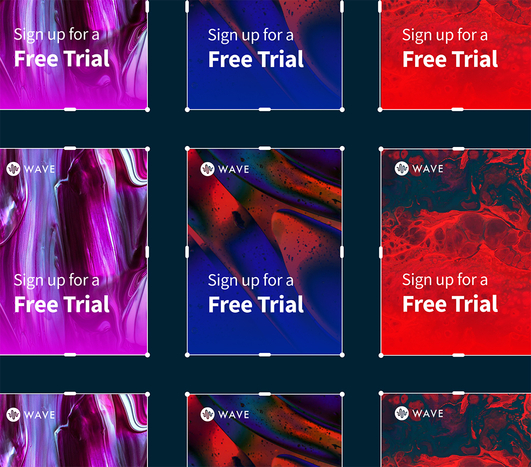2021
EDITIONThe State of Branding Report
Download the report

Introduction
Welcome to the 2021 edition of Bynder and OnBrand’s State of Branding Report. Together with independent research firm Vanson Bourne, we surveyed 1,600 marketing and creative professionals from a variety of functional roles, company sizes, countries, and industries, so we could help you answer some of the biggest questions in branding today.
This report spans the fields of marketing, tech, and creativity and reveals mission-critical insights that relate to some of this year’s most relevant talking points and trends—split into two key sections:
- Digital transformation and digital experience initiatives
- Creative output and automation
By focusing on the challenges and priorities of marketing professionals, our insights will help you take stock of what matters most for marketers in 2021.
Branding is the process of connecting good strategy with good creativity._ Marty Neumeier, The Brand Gap
Snapshot Summary
Here are the key takeaways for 2021:
01Not everyone ventured so heavily into digital initiatives and transformation in 2020, but those who did saw a dramatic increase in content, data, and tech. 59% of marketers reported that the most sizable impact from digital initiatives was generating more digital content and creative output.
02The demand for content never showed any signs of slowing, even during the otherwise wild and unpredictable year that 2020 was. Campaigns and content increased by 41% YoY!
03Marketers may be overestimating their ability to keep up with content demands: 72% of marketers feel confident they are on track to keep up with creative and content requests this year, but 73% of marketers admitted they created significantly less content than they originally planned to in 2020.
04Marketers have a new view on automation. In 2020, 23% said branding can’t be automated - even portions of it. In 2021, only 1% of marketers said the same, suggesting a shift in acceptance towards bringing automation to all parts of marketing — including branding and creative.
Digital transformation and digital experience initiatives

To hear Microsoft’s CEO put it, everyone, and I do mean everyone, digitally transformed almost overnight in 2020. But that’s not quite right. Retailers like U.S. department store company TJMaxx said no thanks, betting hard on the future in-store retail bounce back expected to happen sometime in 2021. Some businesses shut down altogether. And a quarter of marketers halted digital initiatives or never started them.
Digital transformation initiatives hit critical mass, but some brands are still digital caterpillars.
Half of marketers worldwide report they have accelerated digital transformation and digital experience initiatives in 2021. An impressive 24% of respondents report they are already “fully digital.” Almost half of marketers said they are gaining efficiencies through automation due to corporate digital transformation initiatives. But not everyone has evolved into a beautiful, efficient, and tech-forward digital butterfly just yet. 8% have no initiatives in place. And 18% say that digital initiatives slowed or came to a complete standstill in 2021. While digital transformation initiatives have hit critical mass, some brands have fallen behind, some by choice and some by accident.
Digital initiatives mean more content, more tech, and more data for marketers to manage.
The companies that prioritized digital initiatives were faced with the byproducts of digital transformation — more content, more data, and more technology implementations. When asked, “What are the top three impacts of digital transformation initiatives on marketing departments?” respondents said: generating more digital content and creative output (59%), implementing new digital experience technologies (58%), and investing in customer data and analytics (55%).
Technology will help marketers scale content, but responses about where to invest resources show different tactics are in play.
While digital initiatives and their byproducts mean a lot more work for marketers, an overwhelming majority (89%) believe technology will help creativity in their organization’s marketing department. Over half (52%) plan to increase their technology budget to scale content creation. 48% of respondents plan to increase headcount to help address growing content demands in 2021, which is up nearly 10% from 2020 (pre-pandemic.) This headcount investment could also be tied to a shift by many brands to bring creative content in-house. Insourcing of marketing functions has grown by 68% over the past ten years, per Forrester Research. Our research suggests this trend will continue. But consider that 48% of respondents also noted they planned to increase collaboration with external agencies and freelancers. In 2021, marketers are diversifying their investments to scale content production.

also noted they planned to increase collaboration with external agencies and freelancers. In 2021, marketers are diversifying their investments to scale content production.
The pandemic has definitely reshaped marketing. You have to shift from thinking about billboards and huge events to more distributed digital content that’s bite-sized and can be put on multiple channels and that elevates your brand and builds trust. You’re competing for attention right now._ Sarah Franklin, CMO @ Salesforce
Do brands have a mature enough tech and data ecosystem to truly support personalization efforts?
Despite Gartner’s prediction that almost all marketers will abandon personalization by 2025, 82% of respondents still overwhelmingly consider personalization one of the most effective ways of connecting with a consumer. But are brands equipped with mature enough data infrastructure and tech ecosystems to actually and fully support personalization efforts? The survey results say no, not really. 45% of respondents reported that “making sense of inaccurate and inconsistent data” is one of the top three biggest time-wasters in their organization’s marketing department. This finding, coupled with the fact that over half of marketers (52%) plan to invest more in technology, signifies marketers will prioritize data quality and technology investments this year to help upgrade their personalization efforts.

fact that over half of marketers (52%) plan to invest more in technology, signifies marketers will prioritize data quality and technology investments this year to help upgrade their personalization efforts.
How has the pandemic, and subsequent shift to an even more digital world, impacted the demand for content in your organization?

Significant or slight increase in demand for content since the pandemic.

Significant or slight decrease in demand for content since the pandemic.
Significant or slight decrease in demand for content since the pandemic.

No change.
No change.
Creating more content to meet rising demand is the most significant impact of corporate digital transformation initiatives.
Over eight in ten (85%) respondents reported that they have seen an increase in the demand for content in their organization due to the pandemic and subsequent shift to an even more digital world. Over 90% of marketers in video, design, creative, brand strategy, and digital marketing roles, said that creating more content to meet the rising demand for content is the biggest impact that comes with corporate digital transformation initiatives. Not a single marketer working in a video, design, or creative role reported that there had been a decrease or even a slight decrease in the demand for content at their organization.
The creative engine powering digital experience
Digital transformation initiatives significantly increase creative output, but are marketers prepared with the right tech to maintain, tag, and organize their digital content?
A colossal four out of five marketers said that team performance would increase if their organization’s marketing department would just utilize a centralized DAM solution. Yet, only 54% of organizations report DAM is a critical component in their martech stack. According to a recent report from Forrester, 54% of global software decision-makers have implemented, are implementing, or are expanding or upgrading their DAM system.
Creative output and automation

The world might have stopped for a moment in 2020, but campaigns and content accelerated. The volume of campaigns and content increased by 41% from 2020 to 2021! Yet, marketers report they are completely or very confident (72%) they can continue to meet the demand. Still, a quarter expressed reservations about being able to deliver against requests. But the benefits of automation are more strategic than simply keeping up with demand: automation is allowing marketers to carve out time to tackle a bigger concern. For marketers in 2021, that bigger concern isn’t just keeping up with demand, it’s reaching audiences on increasingly congested digital channels.
If we're going to go out there and make our mark on a global scale within a culture that moves so quickly, we need to work smarter and not harder._ Zach Pentel, Head of Brand & Creative at Spotify
Are marketers overly optimistic about their ability to meet content demands and carve out time for more strategic work?
2020 majorly impacted the volume of content produced by marketing departments worldwide. 73% of marketers admitted they meant to create more content in 2020 than they actually ended up producing. Yet, when we asked if they could keep up with creative and content requests in 2021, 72% said they felt completely or very confident. Perhaps, there’s added confidence about their ability to meet the demand due to tactics they are employing to help scale their efforts such as increasing headcount (which 48% plan to do) or repurposing customer and partner content (which 45% plan to do).
Are CMOs out of touch with the content crunch facing creative teams?
What do the people responsible for creating content think versus what their CMO thinks? Across the globe, marketers in CMO or VP level roles reported more confidence than marketers working in video, design, and creative roles about their marketing organization’s ability to meet the creative content demands of 2021, suggesting a mismatch between how these two functions see the content crunch. 79% of respondents in CMO or VP level roles compared to just 62% of marketers in video, design and creative roles say they are “completely confident” in their organization’s ability to meet the creative content demands of 2021.
Creative automation holds the promise of freeing up the time of the creative teams away from cranking out content to meet volume needs._ Andrew Hally, CMO @ Bynder
Ad hoc requests and minor adjustments to fit content to channels are the two biggest time-wasters when it comes to creative output.
While the CMO and the creative director may have different confidence levels about their organization’s ability to meet the creative content demands of 2021, the two roles align more than any other job functions when it comes to agreeing on what’s really slowing them down. 74% of respondents in CMO or VP level roles report creative teams spend too much time on menial tweaks and variations, and 72% of marketers working in video, design, and creative roles report the same.
And according to the CMO, the biggest time-waster in their marketing department is “repetitive, creative production tasks such as format, size, and copy changes to creative.” 13% of marketers worldwide confirmed the meeting could have been an email (13% said internal planning meetings were the biggest time-waster for their marketing team.) And a smug 4% said they don’t waste any time (but we don’t believe them.) Yet, the consensus when you look at responses from other job functions is that customizing assets for specific digital channels and one-off requests that don’t contribute to larger goals are the two biggest time-wasters.

said internal planning meetings were the biggest time-waster for their marketing team.) And a smug 4% said they don’t waste any time (but we don’t believe them.) Yet, the consensus when you look at responses from other job functions is that customizing assets for specific digital channels and one-off requests that don’t contribute to larger goals are the two biggest time-wasters.
Where can creative automation help marketers be more expeditious?
One-off requests that don’t contribute to larger goals are the biggest time wasters for the people responsible for creating content.
Respondents in video, design, and creative roles ranked this as their #1 time- waster.
Only 11% of respondents in Director, VP, or CMO roles reported the same.
Will technology help or hinder creativity in your organization’s marketing department?
No impact.

No impact.

Significantly or somewhat hinder creativity.
Significantly or somewhat hinder creativity.

Significantly or somewhat help creativity.
Marketers hedge their bets on how technology and automation will help creativity.
The vast majority (89%) of respondents said that technology will help creativity in their organization’s marketing department. 96% of creative and marketing agencies and 98% of consumer goods brands say tech will help their creativity, more than any other sector. As automation comes to the next frontier of marketing (creative), sentiment about the relationship between automation, technology, and creativity is changing. Over half of respondents said automation will either increase efficiency, free up time for brand team members to focus on more important tasks, and/or improve brand consistency for their organization.
Marketers warm up to automation for the second year in a row.
Thoughts on automating branding are changing. In 2020, 23% of marketers reported that branding cannot be automated. In 2021, only 1% of marketers said the same. For the 2nd year in a row, creating content more efficiently is the best use of automation, according to marketers. Around half of marketers say that creative automation will help them meet creative output production goals in 2021.
What are marketers using creative automation for?
Marketers rank the following as the top 3 best uses of automation for marketing and branding purposes:
- Create content more efficiently
- Maintain brand consistency
- Enable agile marketing to drive experimentation
Automation is enabling marketers to work on more creative, strategic projects.
There isn’t always enough whitespace for creativity. Are marketers embracing automation as a way to crowd out more time for strateg-ery and creativity? Maybe. Time is, after all, the most valuable commodity and 55% of marketers say automation will increase the efficiency of their efforts. When asked, “What do you wish your marketing department did more of?” the number one answer from respondents was to “work on more creative, strategic projects.” Respondents also said they want to increase automation so they are actually able to work on more creative, strategic projects.
Agencies lead the way when it comes to keeping up with content demands and embracing automation.
Enhancing creative capabilities with technology and automation
Perhaps unsurprisingly, agencies remain the most nimble when it comes to keeping up with the volume of creative content requests (95% say it’s easy to keep up, more than any other sector.) As early adopters, agencies benefit from increasing the use of automation as brands look to outside help to adopt new technologies that are usually difficult to master and use in their early, immature states. This was true for email marketing and programmatic advertising, and now video and design. The reusability and agility of creative automation tools offer plenty of scope for agencies to deliver value in an increasingly automated world.
Methodology and demographics
Research scope and methodology
Bynder commissioned independent market research specialist Vanson Bourne to undertake the research for this report. A total of 1,600 marketing and creative respondents, including senior/C-suite employees, were interviewed during January, February, and March 2021, with representation in the US (600), the UK (400), Germany (225), France (225), and the Netherlands (150). Respondents had to be from organizations with at least 250 employees and came from a range of private and public sectors.
The interviews were conducted online and were undertaken using a rigorous multi-level screening process to ensure that only suitable candidates were given the opportunity to participate. Unless otherwise indicated, the results discussed are based on the total sample.
Industry
| Industry | |
|---|---|
| 14% | Technology |
| 14% | Creative or marketing agency |
| 5% | Consumer goods |
| 10% | Healthcare |
| 11% | Industrial goods and manufacturing |
| 14% | Financial services |
| 11% | Travel and hospitality |
| 8% | Government and education |
| 12% | Other |
Job role
| Job role | |
|---|---|
| 22% | Marketing director/VP of marketing/CMO |
| 27% | Marketing manager |
| 23% | Other marketing roles (marketing executives, consultants, analysts etc.) |
| 11% | Brand strategy manager / director |
| 4% | Design, video, and creative services |
| 5% | Digital marketing services |
| 6% | Marketing operations |
| 2% | Other |
Business type
| Business type | |
|---|---|
| 30% | Business-to-business (B2B) |
| 19% | Business-to-consumer (B2C) |
| 46% | Both B2B and B2C |
| 5% | Non-profit or government |
Company size
| Company size | |
|---|---|
| 19% | 250-499 |
| 21% | 500-999 |
| 21% | 1,000-2,999 |
| 18% | 3,000-4,999 |
| 16% | 5,000-10,000 |
| 5% | More than 10,000 |
About Bynder
Bynder is the creative content engine powering digital experiences for some of the world’s biggest brands like Spotify, PUMA, and Five Guys. Bynder’s digital asset management platform helps teams collaborate in the cloud, get content to market faster, and maximize the impact of marketing assets. Our vision is to elevate marketing creativity to the heart of digital experience so brands can build authentic relationships. Check out Bynder.com for more insights on how you can harness tech to accelerate brand operations and boost workplace creativity.
We’re obsessed with uncovering what’s next in branding, marketing, and technology, and our annual State of Branding Report aims to get to the heart of the biggest questions in branding today. You can check out the 2020 edition here and the COVID-19 Edition here.
We host Europe’s leading branding conference, Studio OnBrand, a series of events bringing together 1,900+ marketing and creative professionals to hear from some of the brightest names in branding today.